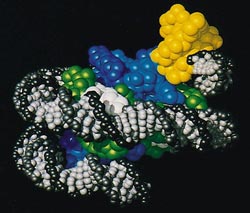New application of physics tools used in biology

This DNA molecule is wrapped twice around a histone octamer, the major structural protein of chromosomes. New studies show they play a role in preserving biological memory when cells divide. Image courtesy of Memorial University of Newfoundland.<br>
Specifically, the team used statistical mechanics and mathematical modeling to shed light on something known as epigenetic memory — how an organism can create a biological memory of some variable condition, such as quality of nutrition or temperature.
“The work highlights the interdisciplinary nature of modern molecular biology, in particular, how the tools and models from mathematics and physics can help clarify problems in biology,” said Ken Kim, a LLNL physicist and one of the authors of a paper appearing in the Feb. 7 issue of Physical Review Letters.
Not all characteristics of living organisms can be explained by their genes alone. Epigenetic processes react with great sensitivity to genes' immediate biochemical surroundings — and further, they pass those reactions on to the next generation.
The team's work on the dynamics of histone protein modification is central to epigenetics. Like genetic changes, epigenetic changes are preserved when a cell divides. Histone proteins were once thought to be static, structural components in chromosomes, but recent studies have shown that histones play an important dynamical role in the machinery responsible for epigenetic regulation.
When histones undergo chemical alterations (histone modification) as a result of some external stimulus, they trigger short-term biological memory of that stimulus within a cell, which can be passed down to its daughter cells. This memory also can be reversed after a few cell division cycles.
Epigenetic modifications are essential in the development and function of cells, but also play a key role in cancer, according to Jianhua Xing, a former LLNL postdoc and current professor at Virginia Tech. “For example, changes in the epigenome can lead to the activation or deactivation of signaling pathways that can lead to tumor formation,” Xing added.
The molecular mechanism underlying epigenetic memory involves complex interactions between histones, DNA and enzymes, which produce modification patterns that are recognized by the cell. To gain insight into such complex systems, the team constructed a mathematical model that captures the essential features of the histone-induced epigenetic memory. The model highlights the “engineering” challenge a cell must constantly face during molecular recognition. It is analogous to restoring a picture with missing parts. The molecular properties of a species have been evolutionarily selected to allow them to “reason” what the missing parts are based on incomplete information pattern inherited from the mother cell.
The research team includes Tech graduate students Hang Zhang and Abhishek Mukhopadhyay and postdoc researcher Xiao-Jun Tian also of Virginia Tech, and Yujin Kim of Foothill High School in Pleasanton, Calif. During this research project, Xing served as a mentor to Yujin Kim.
The research is supported by National Science Foundation grants.
Media Contact
More Information:
http://www.llnl.govAll latest news from the category: Physics and Astronomy
This area deals with the fundamental laws and building blocks of nature and how they interact, the properties and the behavior of matter, and research into space and time and their structures.
innovations-report provides in-depth reports and articles on subjects such as astrophysics, laser technologies, nuclear, quantum, particle and solid-state physics, nanotechnologies, planetary research and findings (Mars, Venus) and developments related to the Hubble Telescope.
Newest articles

Sea slugs inspire highly stretchable biomedical sensor
USC Viterbi School of Engineering researcher Hangbo Zhao presents findings on highly stretchable and customizable microneedles for application in fields including neuroscience, tissue engineering, and wearable bioelectronics. The revolution in…

Twisting and binding matter waves with photons in a cavity
Precisely measuring the energy states of individual atoms has been a historical challenge for physicists due to atomic recoil. When an atom interacts with a photon, the atom “recoils” in…

Nanotubes, nanoparticles, and antibodies detect tiny amounts of fentanyl
New sensor is six orders of magnitude more sensitive than the next best thing. A research team at Pitt led by Alexander Star, a chemistry professor in the Kenneth P. Dietrich…





















